Brihanmumbai Electric Supply and Transport
The Brihanmumbai Electricity Supply and Transport (BEST) is a civic transport and electricity provider public body based in Mumbai, Maharashtra, India. It was originally set up in 1873 as a tramway company called "Bombay Tramway Company Limited". The company set up a captive thermal power station at the Wadi bunder in November 1905 to generate electricity for its trams and positioned it to also supply electricity to the city and re-branded itself to "Bombay Electric Supply & Tramways (BEST)" Company. In 1926, BEST also became an operator of motor buses. In 1947, the BEST became an undertaking of the Municipal Corporation and rebranded itself to "Bombay Electric Supply & Transport (BEST)". In 1995 the organisation was renamed to "Brihanmumbai Electric Supply & Transport (BEST)" alongside Mumbai . It now operates as an autonomous body under the Municipal Corporation.
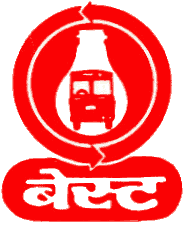 | |
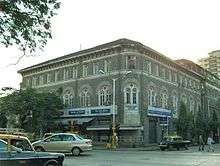 Electric House, Colaba, headquarters of BEST. | |
Formerly | 1873 as Bombay Tramway Company Limited (Horsecar) ---- 1905 as Bombay Electric Supply & Tramways Company Limited (BEST) (Tramways and Electricity) ---- 1947 as Bombay Electric Supply and Transport (BEST) (Transport and Electricity) ---- 1995 as Brihanmumbai Electric Supply & Transport (BEST) (Transport and Electricity) |
|---|---|
| Autonomous State-owned enterprise | |
| Industry | Public transport - Tram (1873–1964), Bus (1926–present) ---- Electricity (1905–present) |
| Founded | Mumbai (1873) |
| Headquarters | Electric House, Colaba, Mumbai, Maharashtra, India |
Key people | Surendra Kumar Bagde , GM; Chairman - Shri Anil Patankar |
| Revenue | |
Number of employees | 44,000 (2005) |
| Parent | Municipal Corporation of Greater Mumbai |
| Website | www.bestundertaking.com |
BEST operates one of India's largest fleets of buses. The bus transport service covers the entire city and also extends its operations outside city limits into neighbouring urban areas. In addition to buses, it also operates a ferry service in the northern reaches of the city. The electricity division of the organisation is also one of the few electricity departments in India to garner an annual gross profit.
History
1865–1873: Early proposals
The idea of a mass public transport system for Bombay was first put forward in 1865 by an American company, which applied for a licence to operate a horse-drawn tramway system. Although a licence was granted, the project was never realized due to the prevailing economic depression in the city due to the end of the American Civil War, during which Bombay had made vast strides in its economy by supplying cotton and textiles to the world market,. On 27 November 1871, a notice in the Times of India newspaper found to be too expensive and the tender was promptly abandoned.
1873–1905: Bombay Tramway Company Limited, introduction of horse-drawn trams
The "Bombay Tramway Company Limited" was formally set up in 1873. After a contract was entered into between the Bombay Tramway Company, the municipality and Stearns and Kitteredge company, the Bombay Presidency enacted "The Bombay Tramways Act, 1874", under which the Company was licensed to run a horsecar tramway service in the city.[1] On 9 May 1874, the first horse-drawn tram made its début in the city, plying on the Colaba–Pydhone via Crawford Market, and Bori Bunder to Pydhonie via Kalbadevi routes. The initial fare was three annas (15 paise) , and no tickets were issued. As the service became increasingly popular, the fare was reduced to two annas (10 paise). Later that year, tickets were issued for the first time to curb increasing ticketless travel.[2] Stearns and Kitteredge reportedly had a stable of 900 horses when tram service began.
In 1882 the municipality entered into an agreement with the Eastern Electric Light and Power Company to provide electric lighting in the Crawford Market and on some of the roads. But the company went into liquidation the following year and the market reverted to gas lighting. In 1899, Bombay Tramway Company applied to the municipality, for operation of electrically operated trams. Due to the high investment required, the company suggested that the Bombay Municipal Corporation (BMC) should waive its right to take over the tramways, which was to take place in 1901 according to the Bombay Tramways Act. Instead, the BMC decided to take over the company, but was met with several legal problems. In 1904 the British Electric Traction Company (England) applied for a license to supply electricity to the city. The "Brush Electrical Engineering Company" was its agent. It got "The Bombay Electric License" on 31 July 1905 signed by Bombay Tramways Company, the Bombay Municipality and its agent, the Brush Electrical Company.
1905–1947: Bombay Electric Supply & Tramway Company Limited, introduction of electric trams and buses
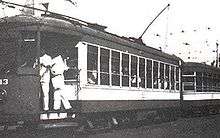
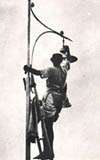
In 1905, "Bombay Electric Supply & Tramway Company Limited" (B.E.S.T.) was formed. The B.E.S.T. Company was granted the monopoly for electric supply and the running of an electric tram service in the city. It bought the assets of the Bombay Tramway Company for Rs.9,850,000.[3] Two years later in 1907, the first electric tram debuted in the city. Later that year, a 4,300 kilowatts (5,800 hp) steam power generator was commissioned at Wari Bunder. In 1916, the Tata Power group began purchasing power and by 1925, all power generation was outsourced from Tata.[4] The passing years aggravated the problem of rush-hour traffic and to ease the situation, double-decker trams were introduced in September 1920.
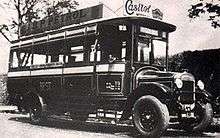
Since 1913, the company had been pondering over starting a motorised bus service. The main factor against its introduction was the high accident rate for a similar service in London. After years of debate, the company came to a decision on 10 February 1926, to start a bus service later that year. Bombay saw its first bus run on 15 July 1926 between Afghan Church and Crawford Market. The people of Bombay received the bus with enthusiasm, but it took some time before this means of conveyance really established itself. Despite stiff opposition and protests by taxi drivers, the service ran without a hitch, transporting 600,000 passengers by the end of that year. The following year the number had increased to 3.8 million. For several years, it was looked upon as transport for the upper-middle class. Those were the days when the tram was the poor man's transport; it carried one all the way from the Sassoon Docks to Dadar. The bus fare for the same journey was 25 paise. In response to the pleas made by the Government and the Bombay Municipal Corporation, the company extended its services to the northern part of the city in 1934. The Indian independence movement's call for mass non-violent strikes and general civil disobedience led to regular service disruptions, leading to the company incurring huge losses in 1929. The next year was a particular bad year for the company in the wake of the Great Depression. To remain solvent, the company decided to introduce discounted fares for short routes, and increase its coverage to the northern portions of the city. In 1937, the introduction of double-decker buses proved to be extremely popular.
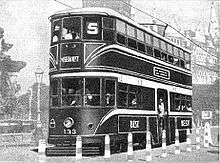
1947–1995: Bombay Electric Supply & Transport, further expansion
Pursuant to the option given to it under the deed of concession granted to the Bombay Electric Supply and Tramways Co. Ltd, the BMC acquired the assets of the combined undertaking, namely the operation of tramways and distribution of electricity in the city of Bombay as a going concern on 7 August 1947. By mutual agreement, the corporation also took over the operation of the bus services, which was run by the Bombay Electric Supply & Transport Company. Thus, "Bombay Electric Supply & Tramways Company" was renamed "Bombay Electric Supply & Transport".[5][6]
As the company grew, it increased its fleet from 242 to 582 buses over the next decade. In 1949, it took over the Bandra Bus Company, which used to ply buses in the suburbs.[7] In 1951, the electricity division switched over from direct current (DC) to the more efficient alternating current (AC). The company launched its services in the eastern suburbs in 1955. That year, the Undertaking and private operators went to court with BEST asking for a complete closure of the private companies. The case dragged on for four years before the Supreme Court of India granted the organisation a complete monopoly over bus services in the Greater Bombay area. In 1964, due to high operational costs and poor public support, its long-running tram services were terminated.[8] The company became the first company in the country to issue computerised billing in 1974. In 1994, the company introduced electronic meters in a move to replace the less accurate electric meters.
1995–present: Brihanmumbai Electric Supply & Transport, recent developments
With the renaming of the city from Bombay to Mumbai in 1995, the organization was renamed to "Brihanmumbai Electric Supply & Transport (BEST)". Following a Supreme Court directive, the company gradually phased out old buses and introduced new buses which complied with the Euro III pollution control standards.[9] In 19 November 2004, route SPL-8 travelling from Churchgate to the World Trade Centre had started accepting cashless smart cards for automatic fare collection in BEST buses. After the 9/11 bombings, BEST had installed an audio-visual surveillance system (CCTV) on each of its buses to monitor suspicious behavior on-board its vehicles but it is no longer done. BEST currently has over 1500 environmentally friendly Compressed Natural Gas (CNG) buses on its fleet and plans to increase the number of buses. Almost all buses have two LCD TVs per bus and some are air-conditioned. The A/C bus "AS-4" from Oshiwara Depot to Backbay Depot is the route with the highest revenue for BEST. BEST had introduced A/C Cerita services on certain routes but due to high maintaince it got discontinued.
Organisational structure
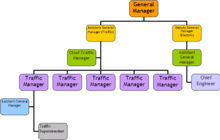
The company is headed by a general manager, currently Surendrakumar Bagde.
The transport department is overseen by a "Deputy General Manager (Traffic Operations)" who is assisted by the "Chief Manager (Traffic)." The 'Chief Manager (Traffic)' oversees the five BEST zones, each headed by a 'Dy. Chief Manager (traffic)'. Each zone consists of 7 to 8 depots, whose operations are overseen by an 'assistant general manager (Traffic Operation)'. A 'Depot Manager' or 'Dy. Depot Manager' heads each depot.[10]
The electricity department is headed by a "Deputy General Manager (Electric Supply)' (DGM (ES))," who is assisted by an "Assistant General Manager (Electric Supply)" (AGM (ES)), and is in charge of planning, new projects, construction, street lighting, computer applications and the generation cell. The "Chief Engineer – Electric Supply" (CEES) is in-charge of material testing and the Standards, Meters and Relays and the Review departments. Two "Chief Engineer – Distribution" (CED) officials manage the two administrative zones.[11]
BEST enjoys a high degree of autonomy under the BMC; the latter approves its yearly budget and permits increases in bus fares when required. A body of 17 municipal corporate officials from the ruling party in the BMC form the BEST committee. The committee, headed by a chairman, keeps a tab on the undertaking's daily operations.[12] The committee has a staggered two-year term.
Transport department
 A BEST double-decker bus
A BEST double-decker bus A CNG powered BEST bus
A CNG powered BEST bus
Rolling stock and Depot
BEST uses CNG and conventional diesel buses. As of January 2015, the BEST has a fleet of 3337 buses.[13] The fleet comprises 602 single-decker diesel buses, 2694 CNG buses, 40 AC Midi buses,1000 Non Ac Midi Buses, and 120 double-decker buses. All are tagged with a route number and its corresponding destination. They are displayed in the front in Marathi and on the side in English.[14] In June 2005 BEST decided to hire buses from private operators instead of procuring new buses to cut costs. These buses would look the same as a regular bus, but the maintenance and salaries would be taken care of by the private operators. However, no buses have been hired by them until 2013.[15] BEST planned to install GPS systems on its buses to monitor them in real-time. It entered into a barter deal with Amnet in 2007 to install three CCTVs in each bus. Amnet also received the rights to advertise in the buses using two LCD screens.[16] To keep this bus fleet roadworthy, a two-tier system of maintenance is followed by Transportation Engineering Department. A workshop located centrally at Dadar acts as one work center. The Dadar workshop has a built-up area of 27,170 square meters. All unit overhauling, repairing of body damages, tyre cut repairs, plant and equipment installation and repairs, and reclamation activities are carried out in the workshop.
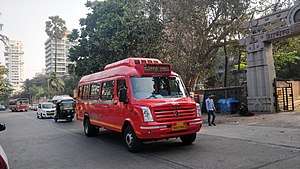
Until BEST was taken over by the municipality, only the Colaba depot was available for the maintenance of buses and minor repairs. As the fleet grew, more depots were needed. In 1961 the fleet comprised 1045 buses. Six new depots were constructed for their maintenance. The Wadala depot was equipped for the maintenance of 300 buses. At this time it was the largest depot in Asia. After this, the authorities decided that no depot should be called on to look after more than 125 to 150 buses after taking long maintenance times into account. Accordingly, small depots were built at convenient spots in the city and its suburbs. Each depot is a work center that provides bus services effectively every day, carries out preventive maintenance, as well as repairs on buses. Depots carry out maintenance practices such as preventive maintenance, unit replacement, RTO passing, body damage repairs of buses. BEST buses are operated out of the 27 bus depot located in four zones viz. City, Central, Western, Eastern & Suburban zones.[17][18]
In late 2019, BEST began operating air-conditioned mini-buses and midi-buses that were hired on a wet lease.[19][20][21]
| No | Depot Name | Depot Code | Address | Bus Route No. | Bus Stations | Major Operations |
|---|---|---|---|---|---|---|
| City Zone | ||||||
| 1 | Colaba | C | Electric House, Colaba, Mumbai | 2L, 6L, 22L, 103, 111, 113, 122, Fort Ferry 2, 1SPL, 4SPL | Colaba Depot, Chht. Shivaji Terminus, Ballard Pier | Colaba, Chht. Shivaji Terminus, Fort |
| 2 | Backbay | BB | Cuffe Parade Road, Backbay, Mumbai | 3, 9, 25L, 45, 100, 106, 108, 112, 114, 120, 121, 132, 133, 134, 136, 137, 138, 139, 8SPL, 9SPL | Backbay Depot, Navy Nagar, Colaba Bus Stn., Ahilyabai Holkar Chk. | Backbay, Nariman Point, Churchgate |
| 3 | Mumbai Central | CN | Morland Road, Byculla, Mumbai | 30L, 42, 48, 49, 63, 68, 102, 104, 105, 123, 126, 130, 135, 154, 155, 156, 157, 166, 351 | Mumbai Central Depot, Ferry Wharf, Jijamata Udyan, Vasantrao Naik Chk., Byculla Stn. [W], | Mumbai Central, Tardeo, Byculla, Mazgaon, Walkeshwar |
| 4 | Worli | WR | Off A. B. Road, Worli, Mumbai | 27, 44, 50, 56, 82, 89, 110, 124, 125, 161, 162, 171 | Worli Depot, Worli Village, Com. P. K. Kurne Chk. | Worli, Dadar (W), Prabhadevi, Parel |
| 5 | Wadala | W | Tilak Road, Opp. Dr. Babasaheb Ambedkar College, Wadala, Mumbai | 16L, 57, 69, 151, 168, 174, 212, 213, 217, 241, 411, 440L, 453L, 504L, 526L | Wadala Depot, P. Thakre Udyan | Wadala, Dadar (E), Sewree |
| Central Suburb Zone | ||||||
| 6 | Marol | M | Central Road, MIDC, Marol, Andheri (E), Mumbai | 22L, 35, 186, 307, 328, 334, 335, 338, 340, 403L, 434, 435, 443, 491L, 522L, 545L, 706L | Marol Depot, Agarkar Chowk, Marol Maroshi Bus Stn. | Andheri (E), Marol, Chandivali, Sahar, Maroshi |
| 7 | Dharavi | DH | Bandra-Sion Link Road, Dharavi, Mumbai | 11L, 87L, 164, 165, 173, 303, 310, 311, 316, 317, 413, BKC-1, BKC-3, BKC-10, BKC-11, BKC-12, BKC-13, BKC-16, BKC-21, BKC-22, BKC-23 | Dharavi Depot, Bandra Rly Ter [E], Bandra Colony Bus Stn., Santacruz Rly Stn(E) | Bandra (E), BKC, Sion, Dharavi |
| 8 | KalaKilla | KK | Bandra-Sion Link Road, Dharavi, Mumbai | 52, 66, 302, 352, 463, C42Exp, C71Exp, C72Exp | KalaKilla Depot, Dharavi Depot, Bandra Rly Ter [E], Bandra Colony Bus Stn. | Bandra (E), BKC, Sion, Dharavi, Trombay, Bhayander Station(E) |
| 9 | Magathane | MT | Near Tata Steel, Western Express Highway, Borivali (E), Mumbai-400066. | 209, 297, 298, 301, 477, 498L, 524L, 698, 700L, 702L, 709L, 710L | Magathane Depot, Borivali Stn. [E], Samata Nagar | Borivali (E), Dahisar (E), Mira Road (E), Bhayandar (E). |
| 10 | Dindoshi | DIN | Film City Road, Dindoshi, Mumbai | 282, 287, 288, 289, 300, 326, 327, 342, 343, 344, 346, 347, 349, 398L, 447, 451, 452, 523L, 525L, 601, 624, 646, 701L, 705L, 718L | Dindoshi Bus Stn, Goregaon Stn [E], Kandivali Bus Stn., Shivshahi Prakalp, N.N.P, Gokuldham | Kandivali (E), Malad (E), Goreagon (E) |
| 11 | Majas | MJ | J.V.L.R, Jogeshwari (E), Mumbai | 39, 264, 308, 332, 333, 392, 415, 428, 441, 442, 492L, 496L | Majas Depot, Seepz Bus Stn., Satbhakti Mandir | Jogeshwari (E), Andheri (E), Seepz |
| 12 | Kurla | K | L.B.S. Road, Kurla (W), Mumbai | 37, 62, 306L, 310, 313, 318, 320, 322, 323, 330L, 332, 365, 426, 446, 507L, 517L, 613, 618, 632 | Kurla Stn. [W], Santacruz Stn. [E], Vidyavihar Bus Stn. | Santacruz (E), Kurla (W), BKC, Vidyavihar(W) |
| Western Suburb Zone | ||||||
| 13 | Bandra | BN | Bandra Rly Stn (W), Mumbai | 1, 61, 86, 211, 214, 215, 220, 225, 321L, 422, 473, 505L, C55Exp | Bandra Bus Stn. [W], Mahim Bus Stn., Bandra Reclamation Bus Stn. | Bandra (W), Khar (W), Mahim (W) |
| 14 | Santacruz | S | Swami Vivekanand Road, Santacruz (W), Mumbai | 1L, 28, 51, 80L, 81L, 83, 224, 229, 231, 339, 356L, 627, C12EXP | Santacruz Depot, Juhu Vileparle Bus Stn., Santacruz Stn. [W] | Santacruz (W), Khar (W), JVPD, Juhu |
| 15 | Goregaon | GG | Near Motilal Nagar, Goregaon (W), Mumbai | 32, 33, 201, 203, 204, 205, 234, 258, 261, 265, 424, 425, 454, 469L, 707L. | Goregaon Depot, Goregaon Bus Stn., Jogeshwari Bus Stn. | Goregaon (W), Jogeshwari (W) |
| 16 | Oshiwara | OSH | Oshiwara Village, Goregaon (W), Mumbai | 200, 221, 223L, 235, 242, 248, 252, 254, 257, 266 | Oshiwara Depot, Andheri Stn. [W], Yari Road Bus Stn. | Jogeshwari (W), Andheri (W), Versova |
| 17 | Poisar | P | Swami Vivekanand Road, Kandivali (W), Mumbai | 210L, 239, 246, 276, 277, 278, 280, 281, 286, 290L | Poisar Depot, Kandivali Stn. [W] | Kandivali (W), Borivali (W) |
| 18 | Gorai | GR | Lokmanya Tilak Road, Gorai, Mumbai | 79, 202L, 206, 208, 226L, 240, 245, 247, 259, 269, 294, 309L, 345, 460L, 461L | Gorai Depot, Borivali Stn. [W], P. Thakre Nagar Bus Stn., Kandharpada Bus Stn. | Gorai, Borivali (W), Dahisar (W) |
| 19 | Malvani | MLV | Malvani, Malad (W), Mumbai | 180, 207, 241, 273, 359L, 456, 459L, 720L | Malvani Depot, Madh Jetty, Marve | Malad (W), Malvani, Madh |
| 20 | Malad | MLD | Chincholi Bunder, Malad (W), Mumbai | 243, 262, 270, 271, 458L, 620, 621, 622 | Malad Depot, Malad Stn. (W), Malad Stn. [E] | Malad (W), Malad (E) |
| Eastern Suburb Zone | ||||||
| 21 | Anik | A | Salt-pan Road, Wadala, Mumbai. | 5, 58, 59, 60, 75, 85, 312, 348L, 360, 361, 362, 363, 367, 369, 377, 431, 432, 501L | Anik Depot, Nehru Nagar Bus Stn., Chunabhatti | Kurla (E), Sion, Anik, Mahul Village, Trombay |
| 22 | Prateeksha Nagar | PN | Salt-pan Road, Wadala, Mumbai | 14, 15, 43, 67, 76, 88, 166, 169, 172, 255L, 312, 341, 448L | Prateeksha Nagar Depot, Antop Hill, Antop Hill Extn. | Antop Hill, Wadala (E), Matunga (E) |
| 23 | Deonar | D | Sion–Trombay Road, Deonar, Mumbai | 21L, 92L, 355L, 364, 380, 382L, 399L, 502L, 506L, 521L, 526L, 663, C21Exp, C50Exp, C60Exp | Deonar Depot, Trombay, Anushakti Nagar | Chembur (E), Trombay, Mankhurd, Anushakti Nagar, Govandi (E), Ghansoli, Nerul, Cheetah Camp |
| 24 | Shivaji Nagar | SN | Govandi, Shivaji Nagar, Mumbai | 8L, 19L, 20L, 329, 350, 357, 358, 366, 375L, 376L, 379, 383, 404, 488L, 489L, C8Exp | Shivaji Nagar Depot, Shivaji Nagar Ter., Dr. Ambedkar Udyan (Chembur W) | Shivaji Nagar, Govandi (W), Chembur(W) |
| 25 | Ghatkopar | G | Ghatkopar (E), Mumbai | 10L, 185, 305, 325, 354, 381, 385, 388L, 394, 397, 419, 421, 430, 470L, 499L, 511L, 533L, C53Exp | Ghatkopar Depot, Ghatkopar Stn (W), Kannamwar Nagar 2 | Ghatkopar (W), Ghatkopar (E), Kannamwar Nagar |
| 26 | Vikhroli | V | L.B.S Road, Vikroli (W), Mumbai | 7L, 331, 386, 387, 410, 418, 478L, 602, 603, 604, 605, 606, 607, 608, 612 | Vikhroli Depot, Bhandup Stn. (W), Kanjurmarg Stn. (W) | Vikhroli (W), Bhandup(W), Kanjurmarg (W), Hiranandani Bus Depot |
| 27 | Mulund | MU | Devidayal Road, Mulund (W), Mumbai | 368L, 373L, 391, 396L, 402, 405, 408, 409L, 412, 484L, 487L, 512L, 513L, C-61Exp, | Mulund Depot, Mulund Stn. (W), Mulund Bus Stn.[W], Mhada Bus Stn. [E] | Mulund (W), Thane, Mulund (E), Nahur |
Bus routes
BEST bus routes are spread citywide and to neighboring cities. BEST operates inter-city services to three areas beyond the municipal limits of Mumbai City; i.e., into the limits of the bordering corporations of Navi Mumbai, Thane, and Mira-Bhayandar. BEST supplements suburban rails, which is the mass carrier in the Mumbai region. It is for this reason that BEST always gives priority for feeder routes over other routes. BEST uses CNG and diesel-powered buses for its operation. BEST introduced Air-conditioned buses in 1998.[22]
The majority of BEST buses consist of ordinary routes. Limited bus services that skip minor stops are used on long routes, high-capacity routes, and routes that provide connectivity beyond Mumbai city. The buses have "Ltd" appended to the route number. 5xx Ltd numbered buses connect Navi Mumbai with Mumbai. Some buses like 503Ltd and 504Ltd go beyond Navi Mumbai and into the Kharghar and Kalamboli areas. Buses number 4xx mostly like 496ltd and 497ltd serve Mulund and Thane and provide the connection to greater Mumbai and buses numbered 7xx Ltd serves Mira-Bhayander region like 706ltd and 720ltd.
As of 2015, the BEST runs a total of 3,600 buses,[13][23] ferrying 5 million passengers[24] over 443 routes, and has a workforce strength of 38,000, which includes 22,000 bus drivers and conductors.
Besides buses, BEST operates a ferry service since 1981 in northern Mumbai, across the Manori Creek. The barges operate at regular intervals across the shallow creek linking Manori to Marve.[25]
The BEST bus service suffered two bombings on 6 December 2002 and 28 July 2003 killing six people. In August 2006, BEST introduced payphone system and CCTVs on its buses as a response to terror attacks on the city's buses and trains.[26]
Types of bus services
| Route | Description |
|---|---|
| Ordinary | Ordinary routes are the most common, with buses on these routes stopping at all stops. Buses traveling on these routes are identified by a white route number on a black background. |
| Limited | Buses on these routes stop only at major stops and skip all the minor stops in between on high volume routes. They used to have a marginally higher fare than ordinary buses and are identified by the route number in red on a white background. In 2008, the fares of Limited and ordinary buses were made equal. The route number ends with LTD. |
| Special | These buses travel on select routes covering railway termini and the central business districts. These routes have a fare marginally higher than the 'Limited' routes and are identified by the route number in white on a red background. |
The routes operated by BEST can be broadly classified in the following categories.
- Feeder Routes: These routes feed the railway stations either from the residential complexes or business districts.
- East-west connectors: These are the routes, which run east/west, where railways have no role to play and connect the western suburb with the eastern suburb.
- Trunk routes: These routes run south-north through the city and are almost parallel to the railways.
- AC express routes: These route runs on western and eastern express highways, to provide faster services to the commuters.
- AC standard routes: These are air-conditioned routes across the city.
The aforementioned routes are further classified into types depending on the number of stops the bus takes and the type of bus used.
Fare
BEST has several options to pay bus fares.
- Single journey (paper ticket issued by the bus conductor)
- Daily pass
The fares vary depending on the type. Paper tickets are valid only for single journey. Commuters have the option to buy a daily pass, distance-wise bus pass values and zonal pass. Students are eligible for discounts on monthly and quarterly passes and senior citizens for discounts on weekly, fortnightly, monthly and quarterly passes.[27]
- Single Journey Fares
Single Journey Fares are valid only for a single trip between any two points. They are issued on paper tickets by the bus conductor. All fare payments must be made in cash. The fare depends on the distance of the destination. Single Journey fare is not valid for transfers. Ordinary and Limited bus service has the same fares.
- Distance-wise bus pass
Distance bus value passes are valid only between two destinations (on a distance basis) on ordinary and limited bus service. Unlimited rides and transfers are available between opted destinations except for single rides. The bus passes are valid for travel between any two destinations up to a distance of a maximum of 20 km. These are issued on an RFID Smart Cards and verified by conductors using a machine. Passes are issued and renewed at all bus depots and also online through the website of BEST undertaking.[28]
- Zonal Pass
Zonal passes can be purchased according to the service type. These can be used on any bus routes(no AC and AC defined). Types of zonal passes available are-
Till the last year 2018 the news of increasing BEST bus fares, it was expected for revised hiked fares which are already twice compared to the last few years. Last time in the year 2016, the plans seemed & reversed with a drop in ticket prices.
Since 2005, B.E.S.T (Brihanmumbai Electric Supply and Transport) did not have a fare hike. On 9 September 2010, the hike was done. Then as 2011 passed and 2012 came the rates increased again, At the end of 2013 the new revised and hiked approved and ticket rates increased. Upon getting approval from the civic body's standing committee and State transport Authority the stretched rates are implemented. Below are the old and latest new revised bus fares by BEST for ordinary and AC buses for Mumbai are implemented."
Reduced Bus Fares Starting 8 July 2019 BEST bus fare cut (Both AC and Regular, Non-AC) which are reduced and ready to gain more commuters. The minimum fare to date (Sunday, 7 July 2019) was Rs.8 for Minimum 2 km distance (Rs 20 for AC Bus) which was hitting heavy to middle-class pocket. The new fares under the new resolution plan decided by Best Committee.
THE NEW BUS FARES ARE AS FOLLOWS:
Up to 5 km: Non-AC Rs 5 | AC Rs 6
Up to 10 km: Non-AC Rs 10 | AC Rs 13
Up to 15 km: Non-AC Rs 15 | AC Rs 19
More than 15 km: Non-AC Rs 20 | AC Rs 25
THE OLD BUS FARES ARE AS FOLLOWS:
2 km: Non-AC Rs 8 | AC Rs 20
6 km: Non-AC Rs 15 | AC Rs 30
10 km: Non-AC Rs 22 | AC Rs 40
20 km: Non-AC Rs 34 | AC Rs 65
BEST Transport Museum
The BEST Transport Museum is at Anik Bus depot at Wadala. The museum was founded by P D Paranjape, the BEST officer who religiously collected bus tickets, engines, ticket-issuing machines from depots across the city. The museum was set up in 1984 at BEST's Kurla depot and was shifted to Anik depot in 1993.[29] The museum traces the evolution of BEST. It houses mini models of charming old BEST buses and ancient trams. Hand-written placards in Marathi and photographs are on display for the public. Entry to the museum is free.[30]
Electric department
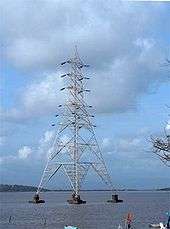
Since 1926, the BEST has been sourcing its power from Tata Power, part of the Tata Group conglomerate. The power cables are laid underground, which reduces pilferage and other losses that plague most other parts of India. The nominal rating of power supplied by BEST is 3-phase, 50 Hz, 220/110 kV. Unlike the transport company, the electricity department services only the Mumbai City area, and not the suburbs. It provides power to 5 million residential and commercial establishments[31] and over 33,000 street lights within the city limits. As of 2000, BEST supplies a total of 700 MW (938,715 hp), with a consumption of 3,216 GWh (11,578 TJ).[32] The electricity department has 6,000 employees. The city has four 110-kV, twenty-two 33-kV and 22-kV substations. BEST has a distribution loss of around 10% (2001), among the lowest in India. In 2006, the RPS (Renewable purchase specification)[33] framework came into force, which has made it mandatory for electricity providers to generate or purchase fixed percentage (6% for FY 2009–10) of their power through renewable sources. To comply with this act, BEST plans to install photovoltaic cells in each of its 25 depots. They also plan to use solar power in gardens and street lighting where the demand is low. Another option being considered is the possibility of using the 7,000 tonnes (6,889 long tons; 7,716 short tons) of garbage disposed by the city on a daily basis, which can be potentially used to generate 350 megawatts (469,358 hp) of electricity.[34]
Issues
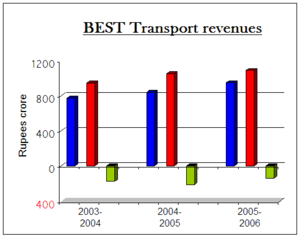
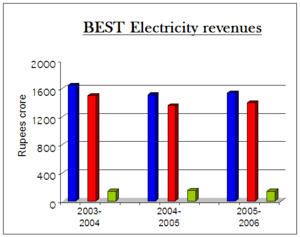
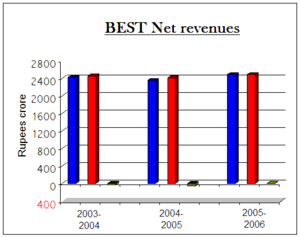
In the financial year 2004–05, the company earned Rs. 15142.2 million[35] from its electricity department, and 839.18 crore from its transport department. Profits from its electricity department totalled Rs. 152.82 crore (US$35m), and losses in its transport department totalled Rs 212.86 crore ($48.8m), giving the company a net loss of Rs. 62.04 crore ($14.2m). For the financial year 2005–06, BEST is expected to earn Rs. 15401.3 million ($352.92m) with a profit of 1408 million ($32.3m) from the electricity department alone. However, its transport department is expected to earn 9486.8 million ($217.39m), with a loss of 1403.0 million ($32.26m). This gives it an estimated net loss of Rs. 5 million ($114,575).[36][37] Newer management techniques, such as retrenching of excess staff (494 till date),[12] and the closure of less patronised routes, have reduced the losses in recent years, from a high of Rs. 1.75 billion ($40.1m) in 2001.[38] Daily earnings from its transport system is Rs. 20 million ($458,450). It collects Rs. 7 million ($160,450) worth of five rupee coins daily, Rs. 4.8 million ($110,000) worth of ten and twenty rupee notes, and Rs. 6 million ($137,535) worth of fifty rupee notes, through its fare collection system. This has led a unique situation wherein it has accumulated a surplus of short change. In July 2005, the company floated tender inquiries to 54 banks to exchange the loose change, which totalled 46.7 million ($1.07m). However, none of the banks sent in a single bid, some citing that their vaults are full, and others saying it would be unprofitable for low denominations, given security considerations.[39]
Though the BEST is a government-owned company, it does not receive any financial assistance from the BMC, or the state government.[12] BEST also earns revenues by way of advertisements on its buses and bus-stops, and through rent from offices on owned properties. The BEST, being a public utility company, cannot increase electricity and bus fares to maximise its profits. An increase, when effected, is usually carried out to curb losses due to inflation. BMC approval is needed before such an increase goes into effect.Prior 2003 the BEST Understanding was a case Peter paying for Paul means the Electricity Division was in profit and Transport loss ,so profit of Electricity was diverted to Transport so break even .The Company down stream started after the inception of Electricity Act 2003 ,in that act it is stated that the profit of Electricity supply cannot be diverted but to be used for same entity. After taking the issue with Maharashtra Electricity Regulatory Commission the company was running by adjusting the profit but after Supreme Court order,it could not adjusted the profit to transport now running in loss.
Culture and awards
BEST has been a quintessential part of life in Mumbai. The red double-decker buses, modelled on the AEC Routemaster buses of London, are one of the defining characteristics of the city. When BEST decided to do away with the double-deckers for operational reasons recently, public protests and sentiment forced it to continue with the service. A move to colour all its buses saffron from red in 1997 also drew in criticism, resulting in the red colour being retained. Bus drivers and conductors have come in for praise in the media for their service during the 2005 Mumbai floods, when they ensured that all the stranded passengers were dropped safely to their respective destinations. A total of 900 buses were damaged.[40]
The organisation has received the following awards for safety and management:[41]
- The prize for the second best production achievement by an urban transport body in the country for the year 1982.
- The second prize for production achievement in Urban Transport during the year 1984.
- A memento for the Administrative Report and Statement of Accounts of the Undertaking for the year 1983–84 awarded by the selection committee nominated by the Institute of Chartered Accountants of India.
- The first place and the Best production achievement award in the category of urban transport for the year 1986–87.
- National Productivity Award for the year 1991–92.
- Award for the best passenger-safety record for the year 1994.
- The award for the Best Passenger-Safety performance in Urban Transport in the whole country instituted by the Association of State Road Transport Undertaking (ASRTU) for the year 1995–96.
- International Road Safety Award for the year 2003.
Future
Among its future plans is the "digitisation project", wherein all underground cables, sub-stations, street lights and bus-stops would be tracked digitally through the geographical information system. It also plans to connect all its electricity meters through a network, so that the readings can be taken remotely, and in realtime, thus obviating the need for monthly manual door-to-door inspection.
See also
References
- "Growth of Mumbai & its Municipal Corporation". Quarterly journal of the Local Self Government Institute (Mumbai). 1976. p. 13.
- David, M. D. (1995). Mumbai , the city of dreams: a history of the first city in India. Himalaya Publishing House. pp. 199–200.
- "Electricity Arrives in Mumbai". BEST Undertaking. Archived from the original on 11 October 2006. Retrieved 12 October 2006.
- "Electricity Arrives in Mumbai". BEST Undertaking. Archived from the original on 8 October 2006. Retrieved 12 October 2006.
- "Motor-Bus Appears". BEST Undertaking. Archived from the original on 15 January 2010. Retrieved 12 October 2006.
- "B.E.S.&T. Company". BEST Undertaking. Archived from the original on 11 October 2006. Retrieved 12 October 2006.
- "Progress of the Bus Service". BEST Undertaking. Archived from the original on 11 October 2006. Retrieved 12 October 2006.
- "Alternative modes of Transport". BEST Undertaking. Archived from the original on 6 October 2006. Retrieved 12 October 2006.
- "Electric Supply". BEST Undertaking. Archived from the original on 9 October 2006. Retrieved 12 October 2006.
- "Organisational Setup". BEST Undertaking. Archived from the original on 4 June 2009. Retrieved 12 October 2006.
- "Organisational Setup". BEST Undertaking. Archived from the original on 29 October 2006. Retrieved 12 October 2006.
- Kuber, Girish (15 August 2005). "Road warrior: City's bus service proves it's BEST". Economic Times. Archived from the original on 29 March 2006. Retrieved 12 October 2006.
- "3 Puneites in race for Sammelan presidentship". The Times of India.
- Mumbai Mirror article published on 29/08/2012
- Albuquerque, Olav (4 June 2005). "BEST to hire buses from private operators". The Times of India. p. 7.
- Rawal, Swapnil (14 March 2007). "BEST firms up deal for CCTVs in buses". Indian Express. Retrieved 10 May 2009.
- "Help line DEPOTS". BEST Undertaking. Archived from the original on 6 March 2001. Retrieved 26 November 2009.
- "Parking Facilities available at BEST Bus Depot". BEST Undertaking. Archived from the original on 17 December 2009. Retrieved 26 November 2009.
- Sen, Somit (12 June 2019). "BEST finally gets go-ahead for 1,250 new buses on wet-lease | Mumbai News - Times of India". The Times of India. Retrieved 22 February 2020.
- Korde, Kailash (9 July 2019). "400 AC buses to make BEST better in Mumbai". Hindustan Times. Retrieved 22 February 2020.
- "New & cool: BEST begins 12 new AC services in town, Andheri". Free Press Journal. 10 December 2019. Retrieved 22 February 2020.
- "A timeline of BEST buses in Mumbai". Daily News and Analysis. Mumbai. 29 June 2013. Retrieved 11 March 2015.
- "Composition of Bus Fleet". BEST Undertaking. Archived from the original on 12 February 2005. Retrieved 12 October 2006.
- "Now running TV ads in Mumbai's BEST buses". Rediff.com. Retrieved 5 August 2011.
- "Bus Transport Profile". Brihanmumbai Electric Supply and Transport (BEST). Archived from the original on 28 June 2002. Retrieved 27 November 2009.
- DNA Correspondent (26 August 2006). "BEST makes a smart move". Daily News & Analysis. Retrieved 12 October 2006.
- "Buspass 2009" (PDF). BEST Undertaking. Archived from the original (PDF) on 29 December 2009. Retrieved 20 November 2009.
- http://www.bestundertaking.com
- Priyanka Bhosale. "Summer Past-time - BEST TRANSPORT MUSEUM, WADALA". Karmayog.org. Retrieved 16 December 2009.
- Time Out Mumbai. "BEST Transport Museum". Time Out Mumbai. Archived from the original on 24 July 2011. Retrieved 16 December 2009.
- The BEST is the best option for Mumbai - Mumbai - DNA. Dnaindia.com. Retrieved on 2013-12-06.
- "Electricity" (PDF). Maharashtra Electricity Regulatory Commission. Retrieved 12 October 2006.
- http://mercindia.org.in/pdf/52_Order_dt_16_08_06_CN_06_of_2006.pdf
- Albuquerque, Olav (8 July 2005). "Short of funds, BEST looks to solar power". The Times of India. p. 3.
- 10 million = 10 million. (See Indian numbering system). Rs 100 million = 230,000 US$ approx. Exchange rate: Rs. 43.6 = 1 US$ as of 2005-08-27.
- 100,000 = 100,000.
- "Finance". BEST Undertaking. Archived from the original on 16 July 2011. Retrieved 12 October 2006.
- Joseph, Manu (21 August 2005). "May the Best Man Win". The Times of India. p. 3.
- Albuquerque, Olav (6 July 2005). "You could now approach BEST for some loose change". The Times of India. TNN. p. 3.
- "Statistics of Mumbai floods 2005". Karmayog. Retrieved 10 May 2009.
- "Awards". BEST Undertaking. Archived from the original on 29 October 2006. Retrieved 12 October 2006.
Notes
- May the Best Man Win; Manu Joseph; Times of India, Mumbai; p. 3; 21 August 2005
- BEST will have to wait to become smart; Ashley D'Mello/Times News Network; p. 3;Times of India; 2 July 2005.
- Short of funds, BEST looks to solar power; Olav Albuquerque; Times of India; p. 3; 8 July 2005.
- Exit clause introduced in BEST-TPC pact; Times News Network; p. 4; Times of India; 7 July 2005.
- BEST to hire buses from private operators; Olav Albuquerque; Times of India; p. 7; 4 June 2005.
- You could now approach BEST for some loose change; Olav Albuquerque/TNN; Times of India; p. 3; 2005-07-06.
External links


- BEST Undertaking – Official site of the BEST.
- "Tram-car arrives". BEST Undertaking. Archived from the original on 22 October 2008. Retrieved 27 August 2005.
- "Motor-Bus appears". BEST Undertaking. Archived from the original on 15 January 2010. Retrieved 27 August 2005.
- "Electricity arrives in Mumbai". BEST Undertaking. Archived from the original on 9 April 2005. Retrieved 27 August 2005.
- "B.E.S.&T. Company". BEST Undertaking. Archived from the original on 3 September 2005. Retrieved 27 August 2005.
- "B.E.S.T. Undertaking". BEST Undertaking. Archived from the original on 8 September 2005. Retrieved 27 August 2005.
- "Progress of Bus Service". BEST Undertaking. Archived from the original on 11 October 2006. Retrieved 27 August 2005.
- "Alternative modes of transport". BEST Undertaking. Archived from the original on 6 October 2006. Retrieved 27 August 2005.
- "Electric Supply". BEST Undertaking. Archived from the original on 9 October 2006. Retrieved 27 August 2005.
- "Organisational Setup (Transport)". BEST Undertaking. Archived from the original on 4 June 2009. Retrieved 27 August 2005.
- "Organisational Setup (Electric)". BEST Undertaking. Archived from the original on 29 October 2006. Retrieved 27 August 2005.
- "Financial Highlights and Budget Estimates". BEST Undertaking. Archived from the original on 16 July 2011. Retrieved 27 August 2005.
- "Awards". BEST Undertaking. Archived from the original on 29 October 2006. Retrieved 27 August 2005.
- "Road warrior: City's bus service proves it's BEST". Economic Times. 15 August 2005. Archived from the original on 29 March 2006. Retrieved 30 August 2005.
- "BEST Committee". Municipal Corporation of Greater Mumbai. Retrieved 30 August 2005.
- "Electricity (.pdf)" (PDF). Maharashtra Electricity Regulatory Commission. Retrieved 30 August 2005.